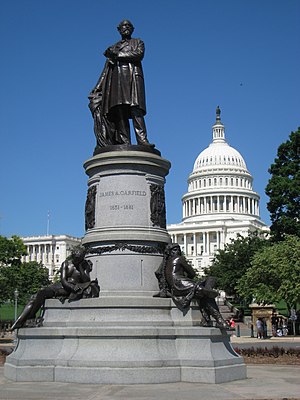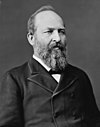
John Quincy Adams Ward was an American sculptor, whose most familiar work is his larger than life-size standing statue of George Washington on the steps of Federal Hall National Memorial in New York City.
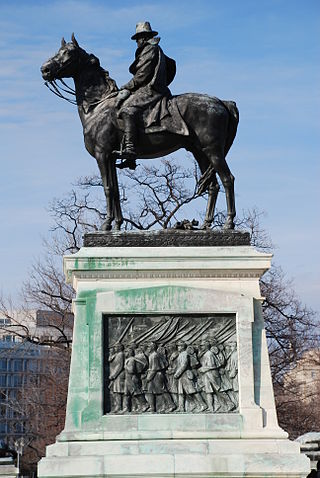
The Ulysses S. Grant Memorial is a presidential memorial in Washington, D.C., honoring American Civil War general and 18th president of the United States, Ulysses S. Grant. It sits at the base of Capitol Hill, below the west front of the United States Capitol. Its central sculpture of Grant on horseback faces west, overlooking the Capitol Reflecting Pool and facing toward the Lincoln Memorial, which honors Grant's wartime president, Abraham Lincoln. Grant's statue is raised on a pedestal decorated with bronze reliefs of the infantry; flanking pedestals hold statues of protective lions and bronze representations of the Union cavalry and artillery. The whole is connected with marble covered platforms, balustrades, and stairs. The Grant and Lincoln memorials define the eastern and western ends, respectively, of the National Mall.

The Peace Monument, also known as the Navy Monument, Naval Monument or Navl-Peace Monument, stands on the western edge of the United States Capitol Complex in Washington, D.C. It is in the middle of Peace Circle, where First Street and Pennsylvania Avenue NW intersect. The surrounding area is Union Square, which the monument shares with the Ulysses S. Grant Memorial, James A. Garfield Monument, and the Capitol Reflecting Pool. The front of the monument faces west towards the National Mall while the east side faces the United States Capitol.

The John Paul Jones Memorial, also known as Commodore John Paul Jones, is a monument in West Potomac Park, Washington, D.C. The memorial honors John Paul Jones, the United States' first naval war hero, and received the Congressional Gold Medal after the American Revolutionary War ended. Jones allegedly said "I have not yet begun to fight!" during the Battle of Flamborough Head.
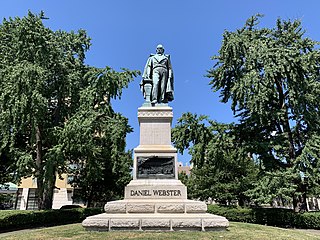
The Daniel Webster Memorial is a monument in Washington, D.C., honoring U.S. statesman and lawyer Daniel Webster. It is located near Webster's former house, beside Scott Circle, at the intersection of Massachusetts Avenue, N Street, and Rhode Island Avenue NW. The person who commissioned the memorial was Stilson Hutchins, founder of The Washington Post, who greatly admired Webster. Congress approved the memorial in 1898 and the dedication ceremony took place in January 1900. Amongst the attendees at the ceremony were President William McKinley and his cabinet, members of Congress, and Supreme Court justices.

Admiral David G. Farragut is a statue in Washington, D.C., honoring David Farragut, a career military officer who served as the first admiral in the United States Navy. The monument is sited in the center of Farragut Square, a city square in downtown Washington, D.C. The statue was sculpted by female artist Vinnie Ream, whose best-known works include a statue of Abraham Lincoln and several statues in the National Statuary Hall Collection. The monument was dedicated in 1881 in an extravagant ceremony attended by President James A. Garfield, members of his cabinet, and thousands of spectators. It was the first monument erected in Washington, D.C., in honor of a naval war hero.

The Luther Monument is a public artwork located in front of Luther Place Memorial Church in Washington, D.C., United States. The monument to Martin Luther, the theologian and Protestant Reformer, is a bronze, full-length portrait. It is a copy of the statue created by Ernst Friedrich August Rietschel as part of the 1868 Luther Monument in Worms, Germany. The version in Washington, D.C., inspired the installation of many other castings across the U.S. The statue is a contributing property to the Luther Place Memorial Church's listing on the National Register of Historic Places (NRHP) and District of Columbia Inventory of Historic Sites (DCIHS). It is also a contributing property to the Greater Fourteenth Street Historic District, which is also listed on the NRHP and DCIHS.

General Philip Sheridan is a bronze sculpture that honors Civil War general Philip Sheridan. The monument was sculpted by Gutzon Borglum, best known for his design of Mount Rushmore. Dedicated in 1908, dignitaries in attendance at the unveiling ceremony included President Theodore Roosevelt, members of the President's cabinet, high-ranking military officers and veterans from the Civil War and Spanish–American War. The equestrian statue is located in the center of Sheridan Circle in the Sheridan-Kalorama neighborhood of Washington, D.C. The bronze statue, surrounded by a plaza and park, is one of eighteen Civil War monuments in Washington, D.C., which were collectively listed on the National Register of Historic Places in 1978. The sculpture and surrounding park are owned and maintained by the National Park Service, a federal agency of the Interior Department.

Lieutenant General George Washington is an 1860 equestrian statue of George Washington, at Washington Circle, at the edge of the George Washington University's campus, in Washington, D.C. The statue was sculpted by Clark Mills, who also created the equestrian statue of Andrew Jackson in front of the White House. The traffic circle where the statue is located was one of the original city designs by Pierre Charles L'Enfant. The statue and surrounding park are in the Foggy Bottom neighborhood at the intersection of 23rd Street, New Hampshire Avenue, and Pennsylvania Avenue NW. The K Street NW underpass runs beneath the circle.
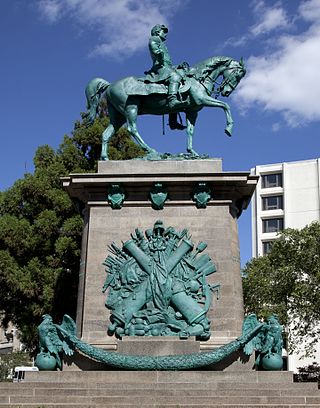
Major General George B. McClellan is an equestrian statue in Washington, D.C. that honors politician and Civil War general George B. McClellan. The monument is sited on a prominent location in the Kalorama Triangle neighborhood due to efforts made by area residents. The statue was sculpted by American artist Frederick William MacMonnies, a graduate of the École des Beaux-Arts whose best known work is a statue of Nathan Hale in New York City. MacMonnies was chosen to design the statue following a lengthy competition organized by a statue commission, led by then Secretary of War William Howard Taft. The monument was dedicated in 1907, with prominent attendees at the ceremony including President Theodore Roosevelt, New York City mayor George B. McClellan Jr., politicians, generals and thousands of military personnel.
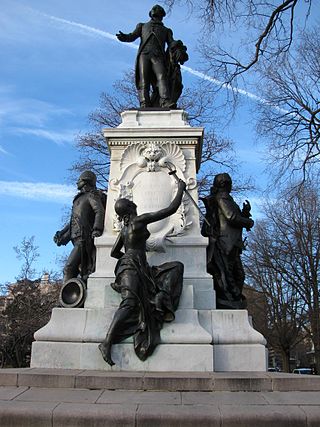
Major General Marquis Gilbert de Lafayette is a statue in the southeast corner of Lafayette Square, in Washington, D.C., near the intersection of Pennsylvania Avenue and Madison Place, across the street from the White House. The statue was erected in 1891 to honor Gilbert du Motier, Marquis de Lafayette, and his contributions in the American Revolutionary War. The square, originally part of the President's Park, was named in honor of the Marquis in 1824 during a visit he made to the U.S. The statuary was made by Alexandre Falguière and Antonin Mercié, and the architect who designed the marble pedestal was Paul Pujol. The monument comprises a bronze statue of the Marquis de Lafayette about 11 ft (3.4 m) high, standing on a French marble pedestal with four faces decorated with classical mouldings, accompanied by seven additional bronze statues, all larger than life size.

Major General George Henry Thomas, also known as the Thomas Circle Monument, is an equestrian sculpture in Washington, D.C. that honors Civil War general George Henry Thomas. The monument is located in the center of Thomas Circle, on the border of the downtown and Logan Circle neighborhoods. It was sculpted by John Quincy Adams Ward, best known for his work on the statue of George Washington in Wall Street, Manhattan. Attendees at the dedication in 1879 included President Rutherford B. Hayes, Generals Irvin McDowell, Philip Sheridan, and William Tecumseh Sherman, senators and thousands of soldiers.
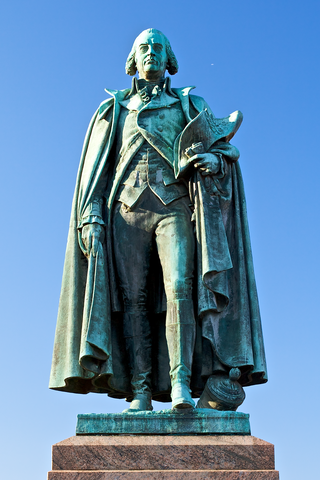
General Artemas Ward is a bronze statue of American Revolutionary War general Artemas Ward. It is sited in the center of Ward Circle, which was specifically made for the statue, at the intersection of Nebraska and Massachusetts Avenue in the American University Park neighborhood of Washington, D.C. The 10-foot (3.0 m) statue of Ward was completed in 1936, but was not unveiled for two years. Ward was the first Commander-in-Chief of colonial forces during the Revolutionary War and served in a number of government roles, including as representative to the United States House of Representatives.

The statue of John Aaron Rawlins, a United States Army general who served during the Civil War and later as Secretary of War, is a focal point of Rawlins Park, a small public park in Washington, D.C.'s Foggy Bottom neighborhood. It was installed in 1874, but relocated several times between 1880 and 1931. The statue was sculpted by French-American artist Joseph A. Bailly, whose best known work is the statue of George Washington in front of Independence Hall in Philadelphia.

Brigadier General Thaddeus Kościuszko is a bronze statue honoring Polish military figure and engineer Tadeusz Kościuszko. The sculpture was dedicated in 1910, the third of four statues in Lafayette Square, Washington, D.C., to honor foreign-born heroes of the American Revolutionary War. Born in the Polish–Lithuanian Commonwealth in 1746, Kościuszko later received education at a Jesuit school before attending the Corps of Cadets in Warsaw. He later traveled to France where he studied in military academy libraries and adopted views of human liberty during the Age of Enlightenment. He moved to the Thirteen Colonies in 1776, where the war with the Kingdom of Great Britain had already begun. Kościuszko served as an engineer in the Continental Army, earning the praise of his superiors, including General George Washington.

Major General Nathanael Greene is a bronze equestrian statue honoring Nathanael Greene, a military leader during the American Revolutionary War. Greene was from modern-day Rhode Island and after laws passed by the Kingdom of Great Britain, along with the burning of one of his ships, Greene formed a state militia. He was later promoted to brigadier general in the Continental Army where he became a trusted adviser to Commander-in-Chief General George Washington. Greene played an active role during the war, participating in battles, sieges, and campaigns from New England to the Southern Colonies. For his service to the war, Greene was offered free land and settled in Georgia with his family. He died a few years later from a heatstroke.

American Revolution Statuary is a group of fourteen statues in Washington, D.C., which honor men whose actions assisted the Thirteen Colonies in their fight against the Kingdom of Great Britain in the American Revolutionary War. They are spread throughout the city, except for the four statues in Lafayette Square, across from the White House, that honor some of the foreign heroes from the war. Some of the statues are located in prominent places, while others are in small parks or stand alone in front of buildings. All of the statues are owned and maintained by the National Park Service, an agency of the United States Department of the Interior. The statuary was collectively listed on the National Register of Historic Places (NRHP) in 1978 and the District of Columbia Inventory of Historic Sites the following year. In addition, most are also contributing properties to historic districts listed on the NRHP.

The Darlington Memorial Fountain, also known as the Joseph Darlington Fountain, Nymph and Fawn, and Darlington Fountain, is a sculpture by C. Paul Jennewein atop a fountain. It is located at Judiciary Park, where 5th Street, D Street, and Indiana Avenue NW intersect in the Judiciary Square neighborhood of Washington, D.C. The fountain is surrounded on three sides by government buildings, including the United States Court of Military Appeals, the H. Carl Moultrie Courthouse, and the former District of Columbia City Hall.

The Samuel Hahnemann Monument, also known as Dr. Samuel Hahnemann, is a public artwork dedicated to Samuel Hahnemann, the founder of homeopathy. It is located on the east side of Scott Circle, a traffic circle in the northwest quadrant of Washington, D.C. The Classical Revival monument consists of an exedra designed by architect Julius Harder and a statue sculpted by Charles Henry Niehaus, whose works include the John Paul Jones Memorial in Washington, D.C., and several statues in the National Statuary Hall Collection. The monument is significant because Hahnemann is the first foreigner not associated with the American Revolution to be honored with a sculpture in Washington, D.C.
